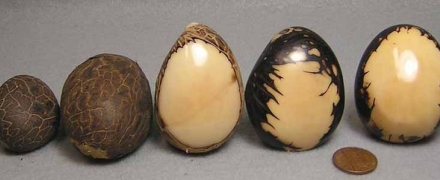open 10 am - 7 pm
laboratory is closed
Jewelry nuts

Since the second half of the 19th century, English jewelers have been looking for unusual materials for inserts into jewelry made in honor of the grief over the royal relatives. Black and dark materials such as jet, morion, black spinel and sherl, dark-colored amber, rhino horn, teardrop pearls ("tears of the sea"), as well as cameos and inserts a la "memory", containing strands hair, fragments of clothing, teeth and even nails. And what in England was defined as a command from above - in the countries of Europe was received with the enthusiasm of the "new wave" of fashion. But gradually jewelry with elements of sorrow gave way to bright materials such as corals, ivory, turquoise, lapis lazuli, rhodonite, malachite, agates and others. By the end of the 19th century, the requirements for observance of mourning weakened and the English court, tired of mourning, also began to join the trends from continental Europe. At this time of the heyday of the colonial policy of European countries in Africa, as souvenirs, carved products from valuable species of wood growing on this continent, including from the Dum-palm nut (Hyphaene thebaica), were imported. Originally used for the production of carved souvenirs, the walnut is being used as an imitation of ivory in the production of costume jewelry. Subsequently, due to the appearance of numerous cheap artificial polymers, the demand for this material fell, and only from time to time rose due to high-profile political events in Africa. At the beginning of the 21st century, due to the demand for environmentally friendly materials, the ban on hunting for elephants and the increased price of fossil proboscis tusks, the nut again became popular as an ornamental and jewelry-ornamental material. You can often find carved inserts made of Dum-palm walnut in the form of inserts not only in silver jewelry, but also in gold jewelry designer items.
В геммологической практике бывают весьма увлекательные случаи с диагностикой ювелирных вставок
Но помимо редкости цвета и высокой стоимости таких камней, многие розовые камни выделяются одной замечательной особенностью – они проявляют плеохроизм, то есть в зависимости от положения осмотра камня он может иметь дополнительные оттенки – оранжевый или пурпурный.
Currently, gemstones are produced by two fundamentally different technological methods - the High Pressure - High Temperature method (“HPHT”, High-pressure & High-temperature) and the Chemical Vapor Deposition (“CVD”, Chemical vapor deposition) method. The "HPHT" method is the most tested classical synthesis method, which can be used both carbon deposition on diamond from flux melts and catalytic reactions. In "CVD" synthesis, diamond growth occurs on a seed during carbon deposition mainly from a gaseous medium at relatively low temperatures and pressures.
Jewelry and precious stones are just such a category of goods, when buying which you need to pay attention to many criteria.
Sogdianite is a rather rare mineral and more often it can be found as a collection material (moreover, in systematic collections), and it is extremely rare in jewelry.






